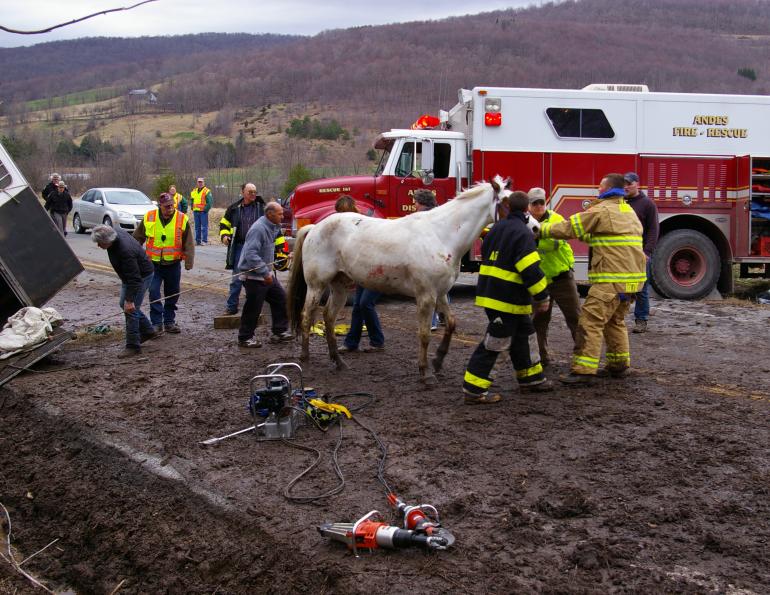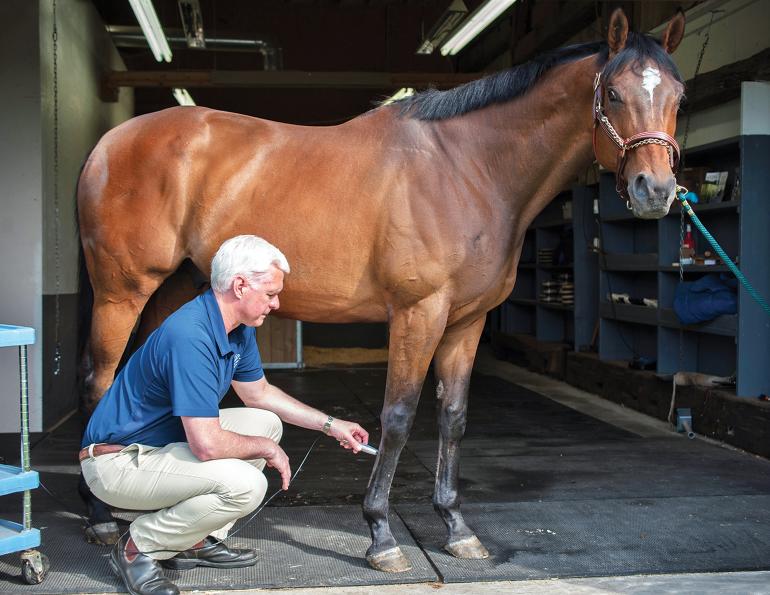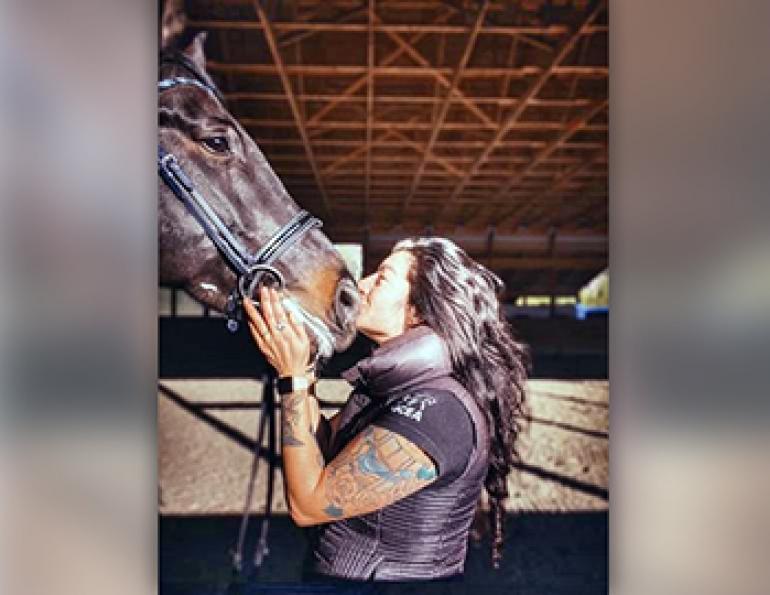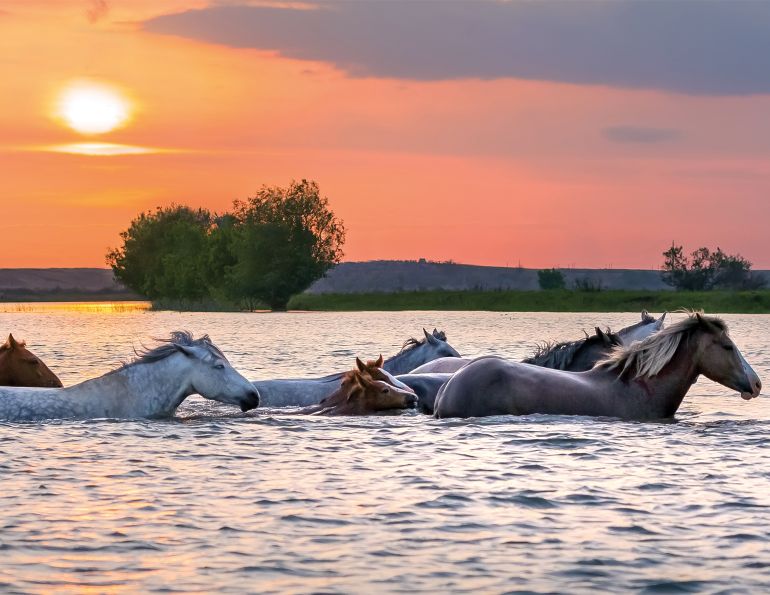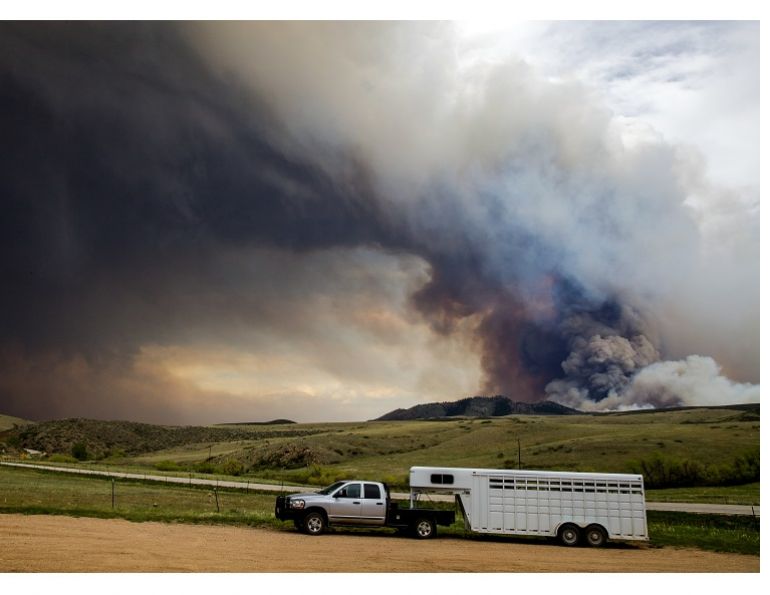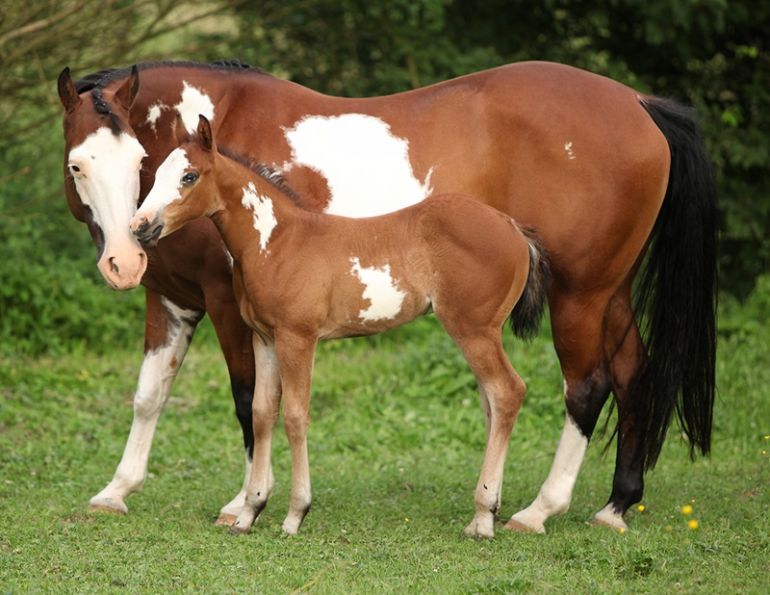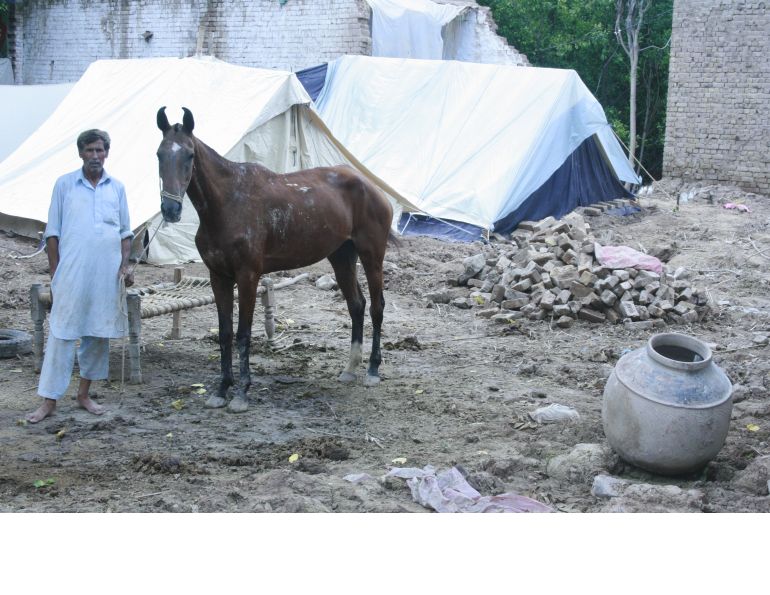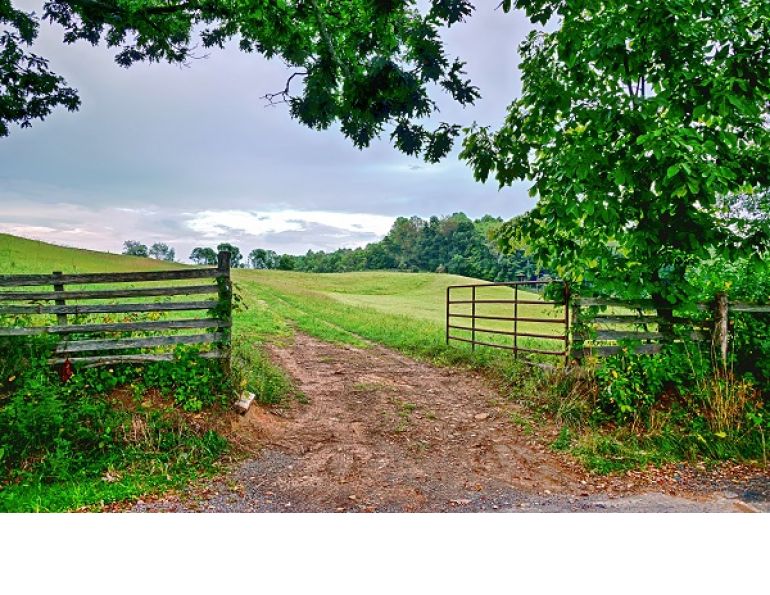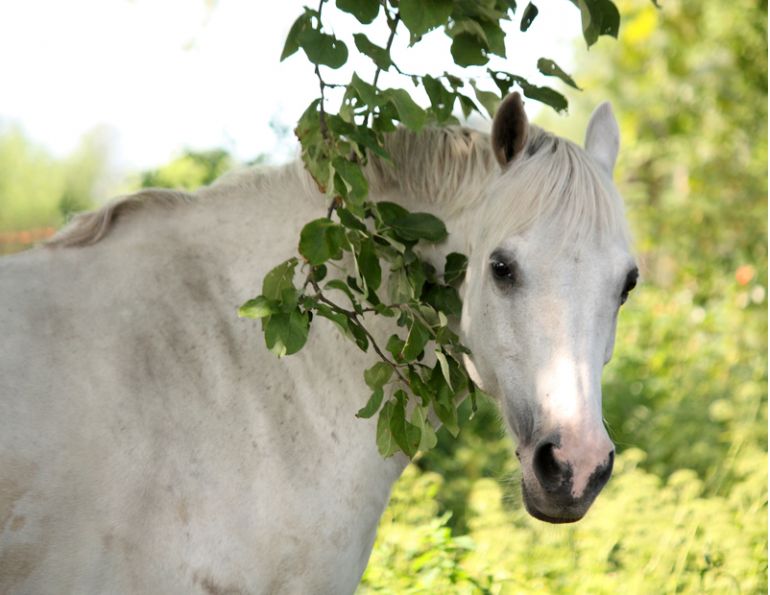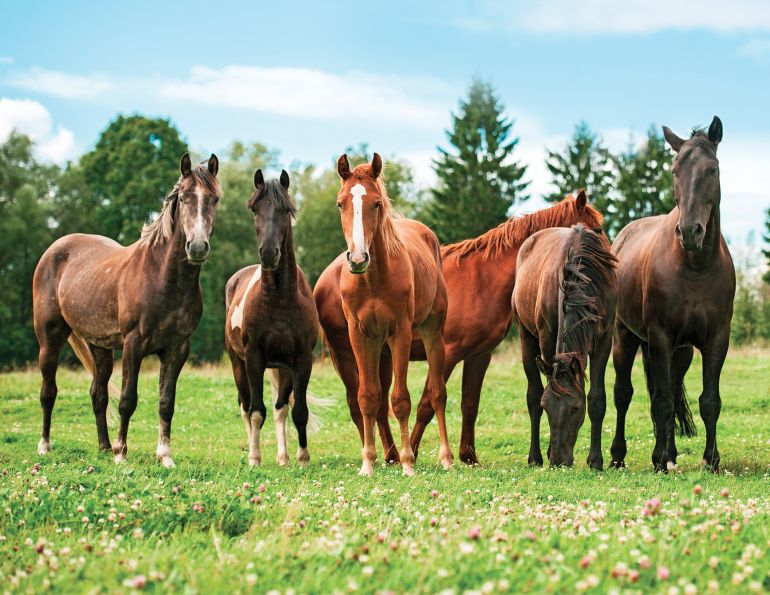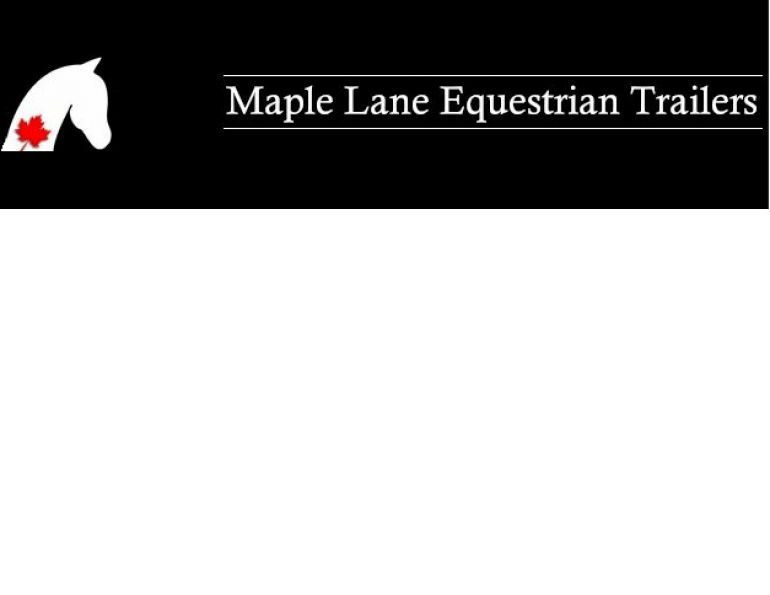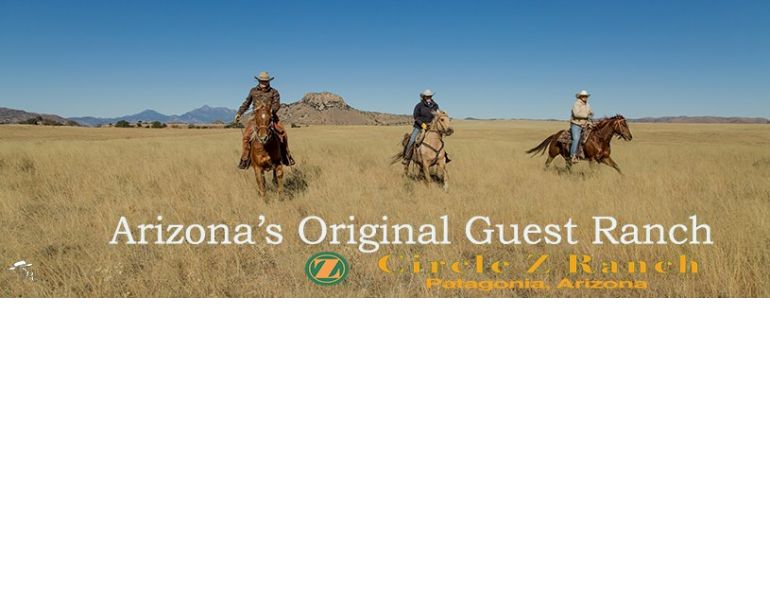By Dr. Erica Koch
Could you save your horse if your trailer overturned on the highway? How about if he was stuck in a ditch? Would you know what to do in a barn fire? Course participants at the Technical Large Animal Emergency Rescue (TLAER™) course, taught by Drs. Tomas and Rebecca Gimenez and hosted by the Atlantic Veterinary College, in Charlottetown, PEI, in early July 2012 learned how to better prepare themselves for everything from small scale emergencies, such as freeing a large animal stuck in mud, to larger scale emergency situations and natural disasters.
The course drew 75 people of different backgrounds from all over Canada, from veterinarians and vet technicians, to first responders, firefighters, and police, industry professionals, and avid horse owners. It was a great mix of people, all of whom contributed diverse perspectives. The first responders were knowledgeable about how to deal with an emergency situation and institute the Incident Command System. This is a unified system that helps bring order to what are frequently extremely disorganized emergency situations by establishing a chain of command and streamlining the efforts of everyone involved toward the common goal of rescuing the animals while keeping the people safe. On the other hand, participants without emergency responder training, but with horse experience, were able to share their knowledge of how the animal may react in an emergency situation. Everybody had something to contribute.
The three day course involved classroom lectures in the morning with hands-on simulated rescue scenarios in the afternoon. Lectures included a wealth of stories and pictures describing rescues gone wrong and rescues performed correctly. Two horses trained specifically for the TLAER™ course, Karma and Torque, were used during the afternoon sessions to demonstrate some rescue scenarios, techniques, and equipment such as rescue glides, slings, and the Nikopolous Needle, which is used to infuse air or water into mud where a large animal is stuck to break up the suction and help free it.
Equine Behaviour
One of the first concepts covered in the course was large animal (horses, cows, etc.) behaviour. When working around these animals it’s important to stay out of potential danger zones around the horse’s head and front legs, and around his hindquarters, in case he strikes out or thrashes in panic. The average horse weighs around 1000 pounds and can generate enough force to do some serious damage.
Horses typically react with a fight or flight response in situations they find stressful or scary, and can be very unpredictable. Participants saw this concept demonstrated firsthand when Torque, who had performed the A-frame lift (used to lift a large animal up and out of a ditch, hole, or ravine) routinely many times before, decided to bolt. This destabilized the structure and caused it to collapse on him. The students all worked as a team to provide first aid and stabilize Torque while ensuring that no people were injured. Meanwhile, others worked to remove fencing, direct a trailer to the scene, and help move the horse up to the veterinary school’s radiology department where he was radiographed and assessed. A treatment plan was efficiently made and Torque was started on supportive care. Fortunately, he made a miraculous recovery and has since returned to the U.S., but we all learned that even in the most prepared situations, accidents can happen, and a successful outcome is more likely to occur when people are prepared and trained personnel are dealing with the emergency.
Stay Safe
One of the biggest challenges in large animal rescue situations is keeping the rescuers safe and out of danger. Whenever an animal is involved in a rescue situation, people will frequently make irrational decisions to try and save the animal, potentially endangering themselves, another rescuer, or even the animal. Rescuer safety is always the first priority.
If you’re the first person on the scene, try to assess the situation keeping in mind the safety of the horse and the rescuers. One of the first things you should do is call local emergency personnel as well as the nearest large animal veterinarian. Think about the type of information they’ll need to allow them to prepare for the situation, e.g. how many rescuers are needed, what kind of equipment, etc.
Consider the environment of the situation so that you may be able to direct and inform rescuers and the veterinarian when they arrive. For example, if a downed horse has slid down a muddy slope, inform rescue personnel if you’ve noticed any unsafe footing or other factors that might put them or the horse at risk.
Above all, it is important to stay calm so that you can work more efficiently to extricate the horse from his predicament as quickly as possible.
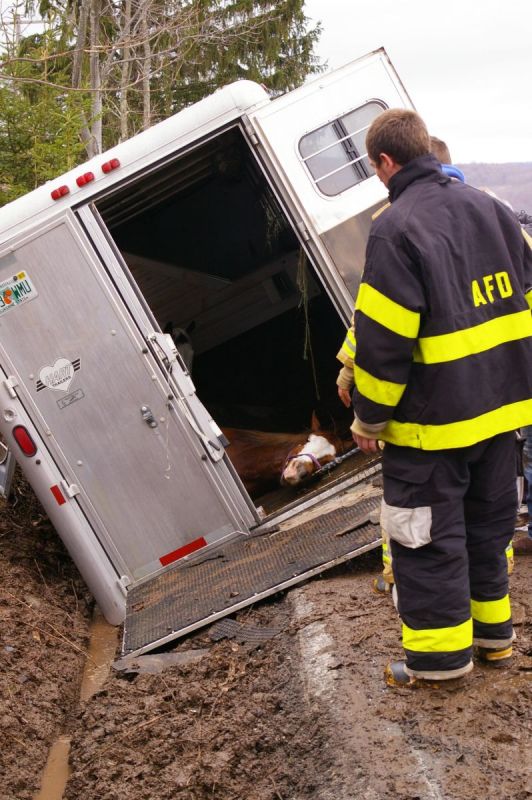
Rescuer safety should always be the number one priority. If there is no safe way to approach the horse, try to think of ways to give him aid while keeping yourself and other rescuers out of harm’s way. Photo: Watershed Post/Flickr
Dealing with a Downed Horse
The first thing to do when dealing with any emergency is to assess the situation calmly and rationally, with the first priority being your safety: Do not put yourself in an unsafe situation. For example, if the horse is stuck in a ditch or ravine, you certainly don’t want to get yourself stuck along with the horse. If the horse is cast in his stall, you don’t want to be trapped in a tight space with him. Call for emergency personnel and a veterinarian, and while you’re waiting for help, ask yourself if there is a safe way for people to get into the stall to help the horse. Or, are you going to have to work to free him from outside the stall? Ropes or straps can be used to help pull the horse into a position from which he’s better able to get up. Assess the horse’s position and place the straps around him accordingly. If you can’t safely get close enough to the horse, devise a way to loop the ropes around the horse using pitchfork handles, brooms, whatever you have available.
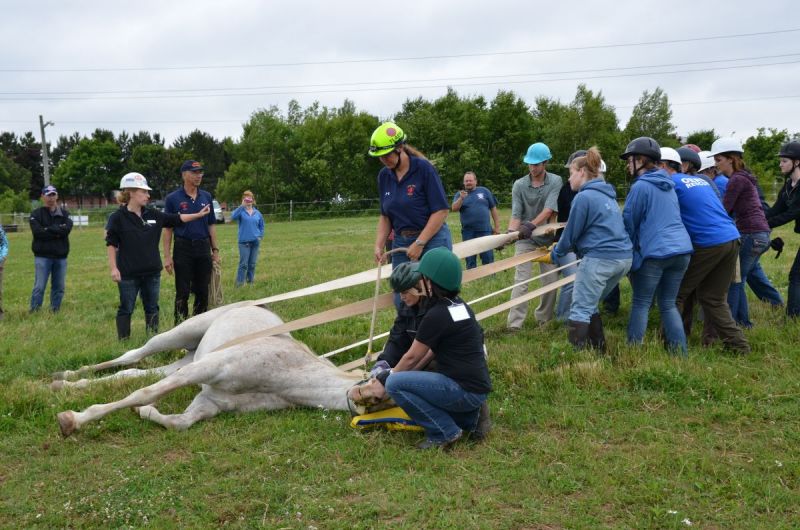
When working around a downed horse, always stand above the horse’s neck and back, never around the horse’s legs. Photo: Pam MacKenzie Photography
A forward assist strap (see photo at left) is ideal because it doesn’t put a lot of pressure on any one joint. It’s not a good idea to tie a rope around the horse’s leg above the hoof and pull because that puts a lot of pressure on the fetlock joint. Never put a rope around a horse’s head and pull him by the neck! You risk cutting off his air supply and it puts a lot of strain on the cervical vertebrae in the neck.
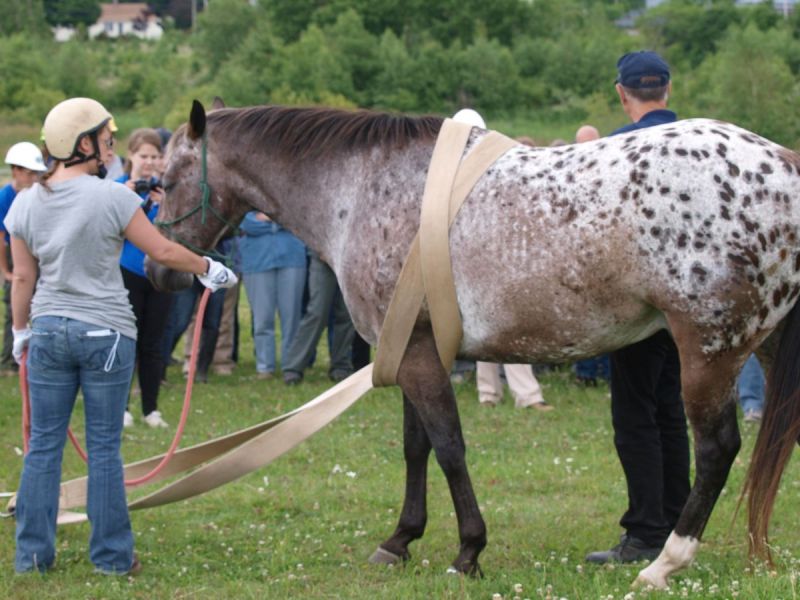
A forward assist strap is the safest way to drag a downed horse from the front as it doesn’t place excessive pressure on any one joint. Don’t drag a horse by one leg and never put a rope around the horse’s neck! Photo: Pam MacKenzie Photography
Trusty Trailering
Trailer safety was a highlighted topic in the course. Most people hauling large animals have never looked at the underside of their trailer – an important step in examining the safety of the wiring and strength of the trailer floor. Trailers with rubber mats should have the mats taken out routinely so that the floor beneath can be cleaned and assessed for rotting or rusting that might affect the structural integrity.

Most trailer owners have never looked at the underside of the trailer to assess the safety of the wiring and the integrity of the floor of the trailer. At the TLAER™ course, participants had the opportunity to examine the underside of an overturned trailer and learn what to look for. Photos: Pam MacKenzie Photography
Course participants were able to carefully overturn a trailer and examine the structure of the floor and wiring. The trailer used was an excellent example of very poor, unsafe wiring, with some wires coming in contact with sharp objects and others hanging low where they would be able to catch on something in the road.
Proper wiring for lighting is vital for signaling to surrounding motorists when turning and braking in order to help prevent accidents. Prior to leaving the driveway, make sure your turning and brake lights are signaling properly. On long hauls, it’s wise to check these functions multiple times along the way, which also allows you to look the truck and trailer up and down quickly to check for any other potential concerns.
Reflective material on the back of the trailer can help alert other motorists of your trailer. If the lights fail, at least others around in the dark should see the trailer if there is enough reflective material on it. You can never have enough reflective stickers on the back of a horse trailer!
For those who haul horses, or any livestock, one of the worst things to be faced with is an accident while pulling a trailer. Overturned trailers on the highway are a challenge for everybody involved. As long as the trailer is stable where it has come to rest, the best way to remove any animal is through an already established door. If this is not possible, exit holes may be cut in the metal wall of the trailer. Always remember to cover the edges of any cut metal with towels, blankets, or even pool “noodles,” as the sharp metal edges may lacerate the people or animals moving through.
Always carry extra halters and leads when trailering. A horse may lose his halter while being removed from the trailer and if this happens there will be no way to prevent him from running into traffic and endangering himself as well as the people and motorists around him.
Fire Follies
For non-firefighter trained personnel, entering a smoke filled building can be a terrifying experience, and trying to save a beloved animal in that smoke adds an element of extreme panic to the situation.
To give course participants the opportunity to feel the chest-constricting nervousness that a firefighter might experience when entering a burning building, a horse barn was filled with fog which simulated smoke from a barn fire. Entering the unfamiliar barn, with no visibility or reference points, the only thing they could identify was a small ray of light coming through a window. The firefighters in the course commented that the visibility in this situation was actually “good,” an opinion which conflicted with those of the other participants!
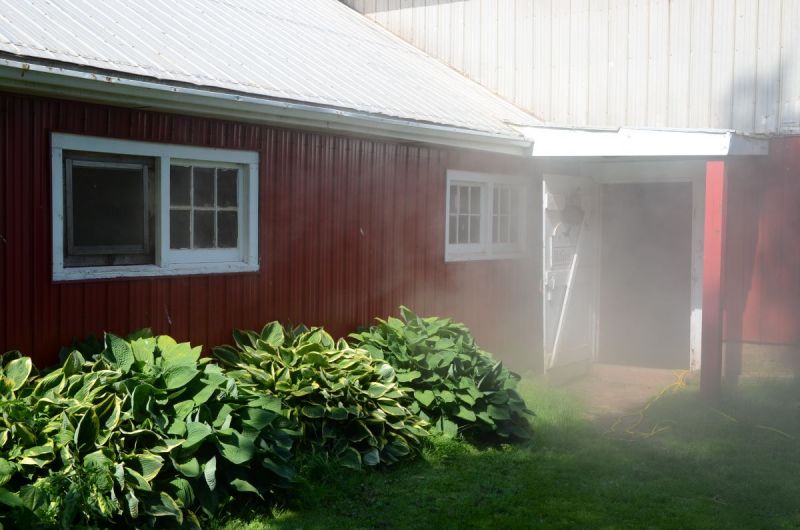
A horse barn was filled with fog to simulate the smoke from a barn fire. Photo: Pam MacKenzie Photography
The experience was crucial in demonstrating the challenges a firefighter faces when approaching a barn fire, and participants learned that time is of the essence. A horse stall bedded with shavings or straw is highly combustible and a fire will spread very quickly.
Remember, your safety comes first! As an owner, you might be tempted to rush into a burning barn to save your horse, but if you have no fire safety training or protective gear, such an action could prove fatal. When it comes to fire safety, preventative measures such as checking your electrical wiring regularly, prohibiting smoking, and keeping your aisles free of clutter, as well as installing early detection devices such as smoke alarms, are key. It is also extremely important to have a safe containment area away from the burning barn to hold the horses that have been safely removed, as they may try to run back into the burning building thinking in their panic that the familiar barn is their safe area.
Helpful Hints
How can you be better prepared in the event you are faced with an equine emergency rescue situation?
1. Make sure the first aid kits in your barn and trailer are up to date and stored in an easily accessible, dry locations.
2. Install fire extinguishers in your barn at all entrances and on all levels. Smoke detectors in the barn should be wired to an alarm in your house.
3. Some pieces of equipment that can come in handy in an emergency rescue situation are:
- Ropes or straps to loop around the horse;
- A pike pole (long shaft with a hook at the end), which can be used to loop ropes or straps around a horse’s body;
- A heavy-duty tarp, which can be slid under a downed horse and used to drag them to a safer area.
4. Keep the phone numbers of your veterinarian and first responders handy and know how to direct them to the farm or the horse’s location.
5. Contact your local fire and police departments, emergency rescue organizations, and local large animal veterinarians to help you develop a large animal rescue team. Create a plan to coordinate large animal rescue equipment and identify what equipment may need to be purchased. Some basic equipment may be donated. Rock climbing gyms may retire ropes that are perfect for large animal rescue equipment stockpiles. Fire departments also may need to retire hoses, which can be used as straps.
To learn more about the TLAER™ course, visit www.tlaer.org.
Dr. Erica Koch graduated from Ross University School of Veterinary Medicine in 2006, after which she completed a one-year internship at Hagyard Equine Medical Institute in Lexington, Kentucky. Upon completion of the internship, she gained practical experience in the ambulatory equine field at TNT Equine in Dover, New Hampshire, and in 2008 began a residency program in Sports Medicine/Field Service at the University of Pennsylvania’s New Bolton Center. After the two-year residency program, Dr. Koch joined the faculty at the Atlantic Veterinary College in Charlottetown, PEI, where she is an assistant professor in the Ambulatory Equine Service. www.avc.upei.ca
Main Article Photo: Watershed Post/Flickr - A good working knowledge of large animal behaviour is crucial when dealing with an equine emergency rescue situation. Many first responders are now trained to know how to handle horses.
This article originally appeared in the October 2012 issue of Canadian Horse Journal.



